Extreme Summer Precipitation Characteristics and Associated Water Vapor Transport in Southern Xinjiang
Abstract
1. Introduction
2. Data and Methods
3. Results
3.1. Spatial Distribution of Extreme Summer Precipitation Characteristics in SXJ
3.2. Spatial and Temporal Trends in Extreme Summer Precipitation Characteristics in SXJ
3.3. Interdecadal Variation in Extreme Summer Precipitation in SXJ
3.4. Physical Mechanisms Associated with Extreme Summer Precipitation Variability in SXJ
3.4.1. Large-Scale Circulation Anomalies
3.4.2. Water Vapor Transport Anomaly
4. Discussion and Conclusions
- The areas with large values of extreme precipitation, extreme precipitation days, and extreme precipitation intensity in summer in SXJ were located in the Tianshan Mountains, at the northern slope of the Kunlun Mountains, and in the Hami region. The areas with large values of extreme precipitation contribution were located in the area around the southern leaning mountains of Kashgar and Hotan and the central part of Bazhou. Apart from extreme precipitation intensity, the other characteristic quantities showed an interdecadal increasing trend over the past 60 years, and the increase in extreme precipitation was likely more associated with an increase in the number of extreme precipitation days. In the western part of SXJ, the Tianshan Mountains, and the Hami area, extreme precipitation, the number of precipitation days, and the contribution of precipitation all exhibited a significant increasing trend. The turning point for the sudden change in extreme precipitation was 1986.
- The large-scale circulation differences that caused the dramatic increase in extreme precipitation after 1986 were as follows: the upper levels in SXJ were dominated by the ascending branch of the western cyclonic circulation, thus leading to enhanced upward motion and dispersion in the upper levels; and the middle and lower levels were dominated by the ascending branch of the anticyclone in Mongolia, thus leading to periodic shifts in the upper airflow in SXJ and enhanced upward motion. In addition, stronger water vapor convergence at lower levels and enhanced atmospheric convective instability combined to cause an increase in extreme summer precipitation in SXJ.
- The anomalous water vapor that caused the increase in extreme precipitation in summer in SXJ originated from the eastward Pacific Ocean and the southward Indian Ocean. Water vapor flow to the eastern, western, and southern boundaries increased and water vapor flow decreased at the northern boundary. The changes in water vapor transport at the southern and northern boundaries were significant and consistent with the trends in extreme precipitation, indicating that meridional water vapor transport was dominant. The changes in water vapor transport on the western, eastern, and northern boundaries were caused by perturbation of the wind field, whereas changes on the southern boundary were caused by perturbation of the water vapor field. Water vapor on the southern boundary was highly correlated with extreme precipitation in the western part of the southern border, which implies that water vapor transport on the southern boundary played a major role in the variations observed in extreme summer precipitation in SXJ after 1986. The water vapor transport at vertical heights exhibited greater input at the eastern and southern boundaries and greater output at the northern boundary. The meridional water vapor transport flux was concentrated in the middle and upper layers, whereas the latitudinal water vapor transport flux was concentrated in the middle and lower layers.
Author Contributions
Funding
Data Availability Statement
Acknowledgments
Conflicts of Interest
References
- Yang, L.M.; Li, X.; Zhang, G.X. Some advances and problems in the study of heavy rain in Xinjiang. Clim. Environ. Res. 2011, 16, 188–198. [Google Scholar]
- Ci, H.; Zhang, Q.; Zhang, J.H.; Bai, Y.G.; Liu, J.Y. Spatiotemporal variations of extreme precipitation events within Xinjiang during 1961–2010. Geogr. Res. 2014, 33, 1881–1891. [Google Scholar]
- Wu, X.L.; Zhang, T.X.; Wang, H.; Yu, X.J.; Zheng, X.N.; Li, H.Y. Facts analysis of temperature and precipitation change of Xinjiang in recent 60 years. Desert Oasis Meteorol. 2020, 14, 27–34. [Google Scholar]
- IPCC. Climate Change 2021: The Physical Science Basis. Contribution of Working Group I to the Fifth Assessment Report of the Intergovernmental Panel on Climate Change; Cambridge University Press: Cambridge, UK; New York, NY, USA, 2021. [Google Scholar]
- Zeng, J.; Guo, F.; Zhao, C.; Sun, Z.Y.; Zhao, Y.J. Climate change of small oases in the southern margin of Taklimakan Desert in recent 50 years. Arid. Zone Geogr. 2014, 37, 948–957. [Google Scholar]
- Han, Y.H.; Ma, Z.G.; Yang, Q.; Pan, Z.H. Changing characteristics of daytime and nighttime precipitation in Xinjiang under global warming. Clim. Environ. Res. 2014, 19, 763–772. [Google Scholar]
- Wang, S.P.; Jiang, F.Q.; Wu, X.B.; Hu, R.J. Temporal and spatial variability of the extreme precipitation indices overthe arid regions in Northwest China from 1961 to 2010. J. Glaciol. Geocryol. 2014, 36, 318–326. [Google Scholar]
- Zou, S.; Duan, W.L.; Christidis, N.; Nover, D.; Abuduwaili, J.; De Maeyer, P.; Van De Voorde, T. An extreme rainfall event in summer 2018 of Hami city in eastern Xinjiang, China. Adv. Clim. Chang. Res. 2021, 12, 795–803. [Google Scholar] [CrossRef]
- Chen, Y.; Ma, Y. Spatial and temporal characteristics of flood and rainstorm disaster in Xinjiang. Arid Land Geogr. 2021, 44, 1515–1524. [Google Scholar]
- Jin, C.; He, Q.; Huang, Q. A review on rainstorm research in southern Xinjiang. Trans. Atmos. Sci. 2023, 46, 82–96. [Google Scholar]
- Wang, Q.; Zhao, Y.; Chen, F.; Yang, Q.; Huang, A.N. Characteristics of different patterns of South Asia high and their relationships with summer precipitation in Xinjiang. Plateau Meteorol. 2017, 36, 1209–1220. [Google Scholar]
- Duan, W.; He, B.; Takara, K.; Luo, P.; Hu, M.; Alias, N.E.; Nover, D. Changes of precipitation features and extremes over Japan between 1901 and 2012 and their connection to climate indices. Clim. Dyn. 2015, 45, 2273–2292. [Google Scholar] [CrossRef]
- Yang, L.M.; Liu, J. Some advances of water vapor research in Xinjiang. J. Nat. Hazards 2018, 27, 1–13. [Google Scholar]
- Ren, G.Q.; Zhao, Y. Relationship between the Subtropical Westerly Jet and Summer Rainfall over Central Asia from 1961 to 2016. Plateau Meteorol. 2022, 41, 1425–1434. [Google Scholar]
- Xu, R.; Ming, J. Patterns of Extreme Precipitation and Characteristics of Related Systems in the Northern Xinjiang Region. Atmosphere 2021, 12, 358. [Google Scholar] [CrossRef]
- Zhang, J.L.; Yang, X.; Shi, J.J. Analysis of the Influence of the Qinghai-Xizang Plateau Weather System on a Rare Rainstorm Process on the Northern Slope of Kunlun Mountain. Plateau Meteorol. 2021, 40, 1002–1011. [Google Scholar]
- Wang, Y.Q.; Feng, J.; Li, J.P.; An, R. Interannual Variation of Summer Precipitation in the Eastern of Northwest China and its Relationship with Circulation. Plateau Meteorol. 2020, 39, 290–300. [Google Scholar]
- Zhang, J.L.; Li, R.Q.; Li, N.; Li, H.H.; Shi, J.J. Preliminary Analysis of the Water Vapor Characteristics of the “July 19” Heavy Rain in 2021 in the Tarim Basin, Xinjiang. Chin. J. Atmos. Sci. 2023, 47, 567–584. [Google Scholar]
- Li, B.; Li, Y.Y.; Chen, Y.R. Research Progress of Tibetan Plateau Vortex and Central Asian Vortex in Recent Decade. Plateau Mt. Meteorol. Res. 2023, 43, 17–27. [Google Scholar]
- Zhuang, X.C.; Li, R.Q.; Li, B.Y.; Li, J.L.; Sun, Z.J. Analysis on Rainstorm Caused by Central Asian Vortex in Northern Xinjiang. Meteor. Mon. 2017, 43, 924–935. [Google Scholar]
- Ayitken, M.; Yang, L.M.; Zhang, Y.H.; Musa, Y. Characteristic analysis of environment of short-time heavy rainfall under the background of the Central Asian Vortex in Xinjiang in recent ten years. Arid Zone Geogr. 2018, 41, 273–281. [Google Scholar]
- Yang, T.; Yang, L.M.; Li, J.G.; Zhou, Y.S.; Ran, L.K. Review of studies about Central Asian vortex and its influence on heavy precipitation in Xinjiang. Torrential Rain Disasters 2022, 41, 613–620. [Google Scholar]
- Guo, N.; Zhou, Y.; Yang, L. Statistical analysis of Central Asian vortices and their influence on precipitation in Xinjiang. Atmos. Res. 2021, 249, 105327. [Google Scholar] [CrossRef]
- Huang, W.; Feng, S.; Chen, J.; Chen, F. Physical mechanisms of summer precipitation variations in the Tarim Basin in northwestern China. J. Clim. 2015, 28, 3579–3591. [Google Scholar] [CrossRef]
- Hua, L.; Zhong, L.; Ma, Z. Decadal transition of moisture sources and transport in northwestern China during summer from 1982 to 2010. J. Geophys. Res. Atmos. 2017, 122, 12522–12540. [Google Scholar] [CrossRef]
- Bothe, O.; Fraedrich, K.; Zhu, X. Precipitation climate of Central Asia and the large-scale atmospheric circulation. Theor. Appl. Climatol. 2012, 108, 345–354. [Google Scholar] [CrossRef]
- Wang, S.; Zhang, M.; Sun, M.; Wang, B.; Li, X. Changes in precipitation extremes in alpine areas of the Chinese Tianshan Mountains, central Asia, 1961–2011. Quat. Int. 2013, 311, 97–107. [Google Scholar] [CrossRef]
- Zhang, J.; Chen, Z.; Chen, H.; Ma, Q.; Teshome, A. North Atlantic multidecadal variability enhancing decadal extratropical extremes in boreal late summer in the early twenty-first century. J. Clim. 2020, 33, 6047–6064. [Google Scholar] [CrossRef]
- Zhao, Y.; Huang, A.; Zhou, Y.; Huang, D.; Yang, Q.; Ma, Y.; Li, M.; Wei, G. Impact of the Middle and Upper Tropospheric Cooling over Central Asia on the Summer Rainfall in the Tarim Basin, China. J. Clim. 2014, 27, 4721–4732. [Google Scholar] [CrossRef]
- Zhao, Y.; Huang, A.; Zhou, Y.; Yang, Q. The impacts of the summer plateau monsoon over the Tibetan Plateau on the rainfall in the Tarim Basin, China. Theor. Appl. Climatol. 2016, 126, 265–272. [Google Scholar] [CrossRef]
- Chen, C.; Zhang, X.; Lu, H.; Jin, L.; Du, Y.; Chen, F. Increasing summer precipitation in arid Central Asia linked to the weakening of the East Asian summer monsoon in the recent decades. Int. J. Climatol. 2021, 41, 1024–1038. [Google Scholar] [CrossRef]
- Ding, Y.H.; Hu, G.Q. A study on water vapor budgetover China during the 1998 severe flood periods. Acta Meteor. Sin. 2003, 61, 129–145. [Google Scholar]
- Li, J.L.; Li, Z.R.; Yang, J.C.; Shi, Y.Z.; Fu, J. Analyses on Spatial Distribution and Temporal Variation of Atmosphere Water Vapor over Northwest China in Summer of Later 10 Years. Plateau Meteorol. 2012, 31, 1574–1581. [Google Scholar]
- Xu, X.; Shi, X.; Wang, Y.; Peng, S.; Shi, X. Data analysis and numerical simulation of moisture source and transport associated with summer precipitation in the Yangtze River Valley over China. Meteorol. Atmos. Phys. 2008, 100, 217–231. [Google Scholar] [CrossRef]
- Jiang, X.L.; Ma, Z.G.; Gong, Y.F. Comparative Analysis of Relationship between Moisture Budget and Precipitation Changes among Global Significantly Wetting/Drying Regions. Plateau Meteorol. 2015, 34, 1279–1291. [Google Scholar]
- Wang, Y.X.; Yan, H.M.; Jin, Y.; Peng, Q.X. Characteristics of Water Vapor Transport over the Low-Latitude Highlands and its Effect on Yunnan Climate. Plateau Meteorol. 2020, 39, 925–934. [Google Scholar]
- Pan, F.; He, D.M.; Cao, J.; Lu, Y. Multiple branches of water vapor transport over the Nujiang River Basin in summer and its impact on precipitation. Acta Geogr. Sin. 2023, 78, 87–100. [Google Scholar]
- Zhou, C.Y.; Jiang, X.W.; Li, Y.Q.; Wei, G.C. Features of Climate Change of Water Vapor Resource overEastern Region of the Tibetan Plateau and Its Surroundings. Plateau Meteorol. 2009, 28, 55–63. [Google Scholar]
- Xu, X.D.; Tao, S.Y.; Wang, J.Z.; Chen, L.S.; Zhou, L.; Wang, X.R. The relationship between water vapor transport features of Tibetan Plateau-Monsoon “Large triangle” affecting region and drought-flood abnormality of China. Acta Meteorol. Sin. 2002, 60, 258–264. [Google Scholar]
- Wang, K.L.; Jiang, H.; Zhao, H.Y. Atmospheric water vapor transport from westerly and monsoon over the Northwest China. Adv. Water Sci. 2005, 16, 432–438. [Google Scholar]
- Wei, N.; Gong, Y.F.; Sun, X.; Fang, J.G. Variation of Precipitation and Water Vapor Transport over the Northwest China from 1959 to 2005. J. Desert Res. 2010, 30, 1450–1457. [Google Scholar]
- Huang, W.; Chang, S.Q.; Xie, C.L.; Zhang, Z.P. Moisture sources of extreme summer precipitation events in North Xinjiang and their relationship with atmospheric circulation. Adv. Clim. Chang. Res. 2017, 8, 12–17. [Google Scholar] [CrossRef]
- He, J.H.; Liu, Y.Y.; Chang, Y. Analysis of summer precipitation anomaly and the feature of water vapor transport and circulation in Northwest China. J. Arid Meteorol. 2005, 23, 10–16. [Google Scholar]
- Yu, Y.X.; Wang, J.S.; Li, Q.Y. Spatial and Temporal Distribution of Water Vapor and Its Variation Trend in Atmosphere over Northwest China. J. Glaciol. Geocryol. 2003, 25, 149–156. [Google Scholar]
- Wang, X.R.; Xu, X.D.; Wang, W.G. Charateristic of Spatial Transportation of Water Vapor for Northwest China’s Rainfall in Spring and Summer. Plateau Meteorol. 2007, 26, 749–758. [Google Scholar]
- Li, W.L.; Wang, K.L.; Fu, S.M.; Jiang, H. The interrelationship between regional westerly index and the water vapor budget in Northwest China. J. Glaciol. Geocryol. 2008, 30, 28–34. [Google Scholar]
- Zhang, W.C.; Tang, Y.; Zheng, J.M.; Cao, J.; Ma, T. Impacts of the vapor transportation by summer monsoon on drought and flooding in summer of Yunnan. J. Nat. Resour. 2012, 27, 293–301. [Google Scholar]
- Li, Y.H.; Xu, H.M.; Gao, Y.H.; Li, Q. The characteristics of moisture transport associatied with drought/flood in summer over the east of the southwestern China. Acta Meteor. Sin. 2010, 68, 932–943. [Google Scholar]
- Liu, Z.L.; Zhang, X.P.; Li, Z.X.; He, X.G.; Guan, H.D. Spatial-temporal distribution characteristics of droughts /floods abnormality in the Dongting Lake Basin and its relationship with atmospheric circulation and water vapor transport. Resour. Environ. Yangtze Basin 2021, 30, 721–733. [Google Scholar]
- Ke, H.; Yin, Y.X.; Wang, X.J.; Luo, Z.W.; Liu, M.Y. Characteristics of summer drought and water vapor differences in typical drought and flood years in the coastal provinces. J. China Hydrol. 2022, 42, 29–34. [Google Scholar]
- Zhou, C.; Li, Y.; Peng, J. The characteristics and variation of precipitation and water resource of Sichuan and Chongqing basin on the eastern side of the plateau. Chin. J. Atmos. Sci. 2006, 30, 1217. [Google Scholar]
- Wu, J.; Gao, X.J. A gridded daily observation dataset over China region and comparison with the other datasets. Chin. J. Geophys. 2013, 56, 1102–1111. [Google Scholar]
- Xue, L.Q.; Liu, X.Q.; Song, J.J.; Zhang, Z.Q.; Li, X.C. Determine threshold of basin extreme events based on percentile method analysis. J. Hydroelectr. Eng. 2013, 32, 26–29. [Google Scholar]
- Chi, X.X.; Yin, Z.E.; Wang, X.; Sun, Y.K. A comparison of methods for benchmarking the threshold of daily precipitation extremes in China. J. Catastrophology 2015, 30, 186–190. [Google Scholar]
- Yang, Z.X.; Qi, P.; Sun, L.; Cui, X.P.; Zhao, Y.L. Thresholds determination and characteristics analysis of short-time heavy rainfall in the Northeast side of Qinghai Tibet Plateau. J. Arid Meteorol. 2021, 39, 563–568. [Google Scholar]
- Trenberth, K.E. Climate diagnostics from global analyses: Conservation of mass in ECMWF analyses. J. Clim. 1991, 4, 707–722. [Google Scholar] [CrossRef]
- Xu, K.; Zhong, L.; Ma, Y.; Zou, M.; Huang, Z. A study on the water vapor transport trend and water vapor source of the Tibetan Plateau. Theor. Appl. Climatol. 2020, 140, 1031–1042. [Google Scholar] [CrossRef]
- Xu, D.; Kong, Y.; Wang, C.H. Changes of Water Vapor Budget in Arid Area of Northwest China and Its Relationship with Precipitation. J. Arid Meteorol. 2016, 34, 431–439. [Google Scholar]
- Liu, H.B.; Dong, L.; Yan, R.J.; Zhang, X.C.; Guo, C.; Liang, S.C.; Tu, J.L.; Feng, X.D.; Wang, X.L. Evaluation of Near-Surface Wind Speed Climatology and Long-Term Trend over China’s Mainland Region Based on ERA5 Reanalysis. Clim. Environ. Res. 2021, 26, 299–311. [Google Scholar]
- Liu, J.; Chen, Y.; Wang, M.; Zhou, X.M. Comparison of the Applicability between ERA-Interim and ERA5 Reanalysis in Complex Terrain Area of Southwest China. Plateau Mt. Meteorol. Res. 2023, 43, 95–103. [Google Scholar]
- Wang, T.Z.; Zhao, Y. Relationships between Thermal Anomalies over the Qinghai-Xizang Plateau and Tropical Indian Ocean in May with Summer Rainfall in Xinjiang. Plateau Meteorol. 2021, 40, 1–14. [Google Scholar]
- Niu, M.M.; Zhang, J.; Ma, Q.R.; Chen, Z.H. Influence of Indian Ocean Warming on Extreme Precipitation in the Western Tianshan Mountains from Late Spring to Early Summer. Chin. J. Atmos. Sci. 2023, 47, 295–310. [Google Scholar]
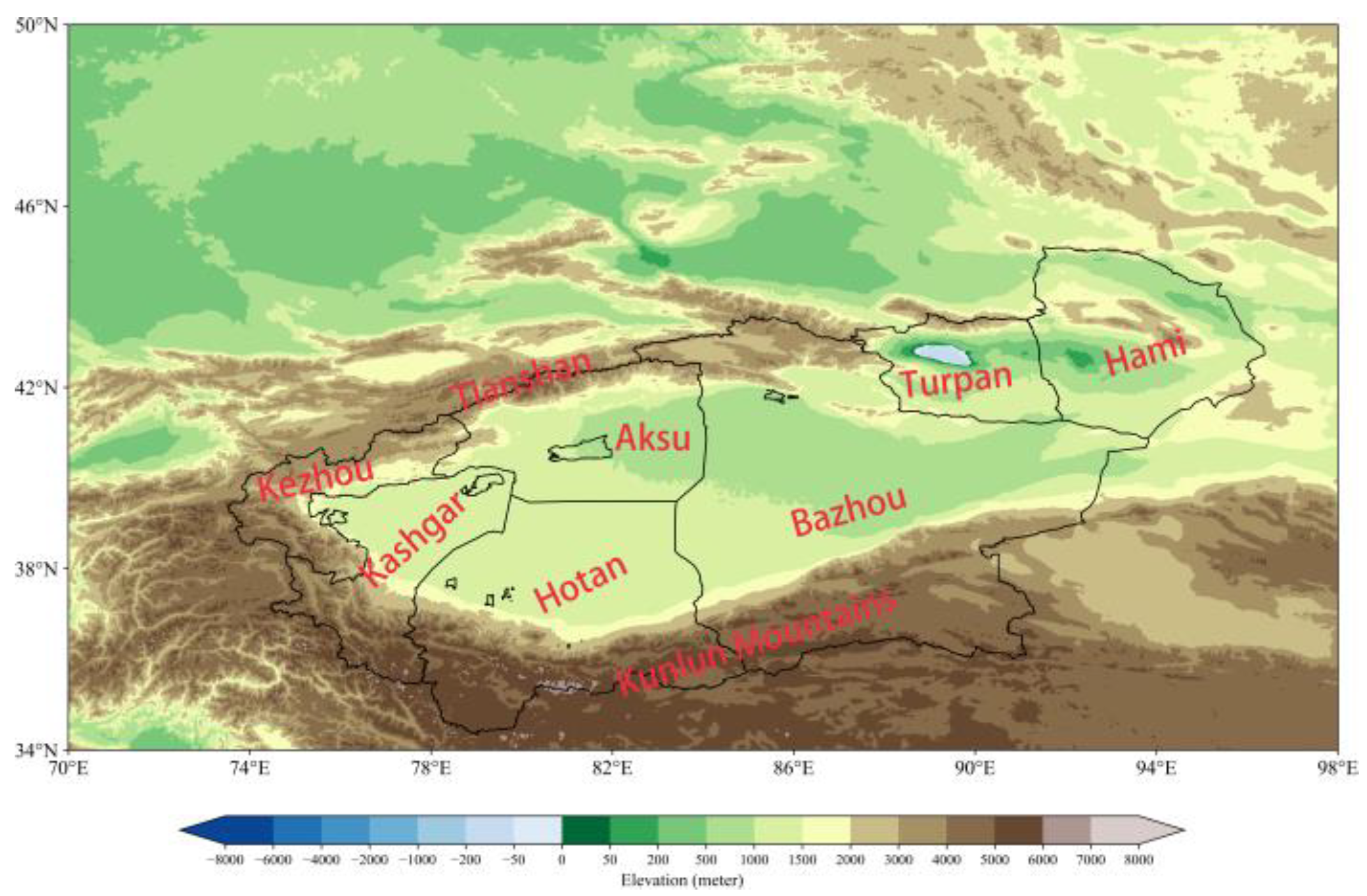
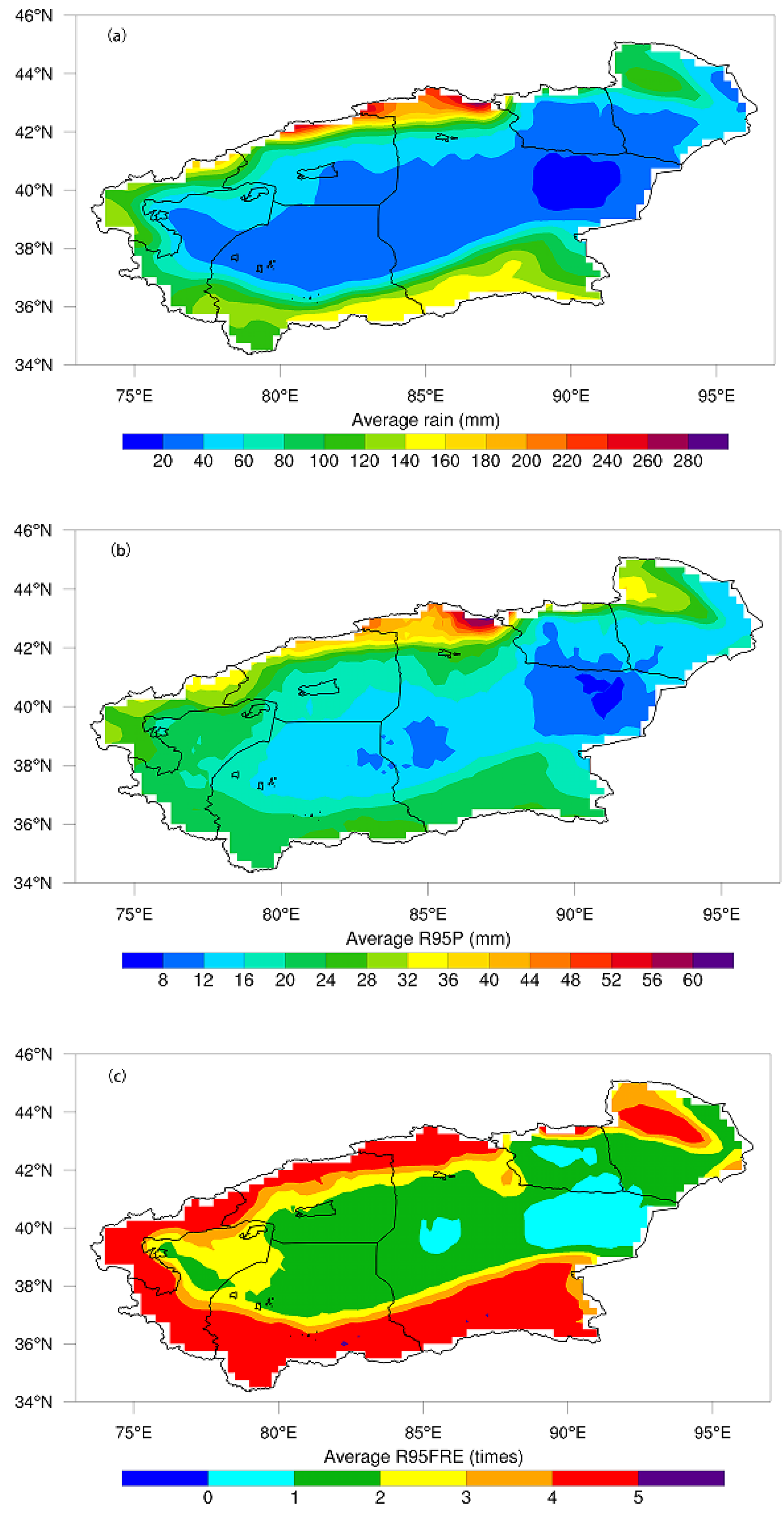
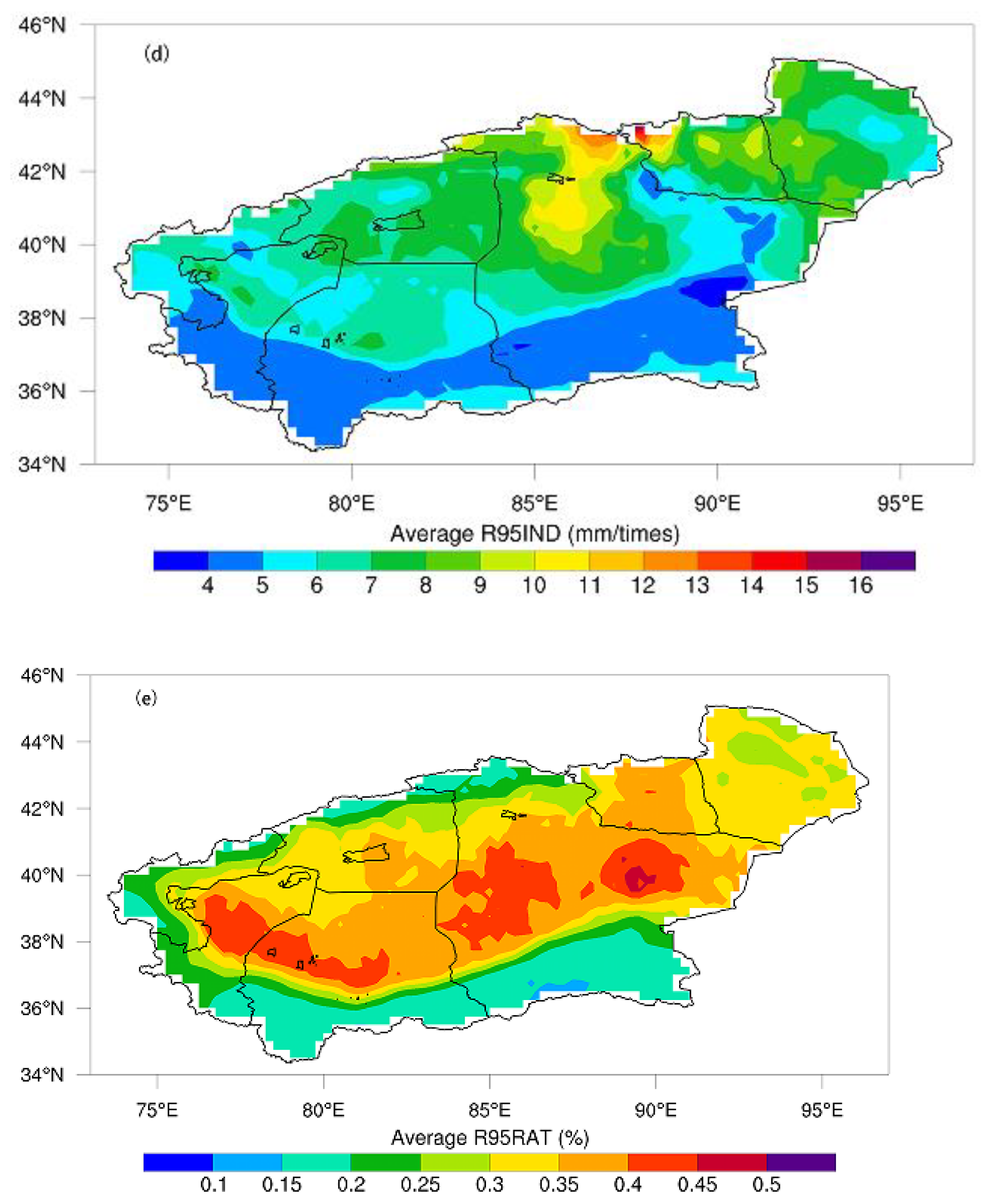
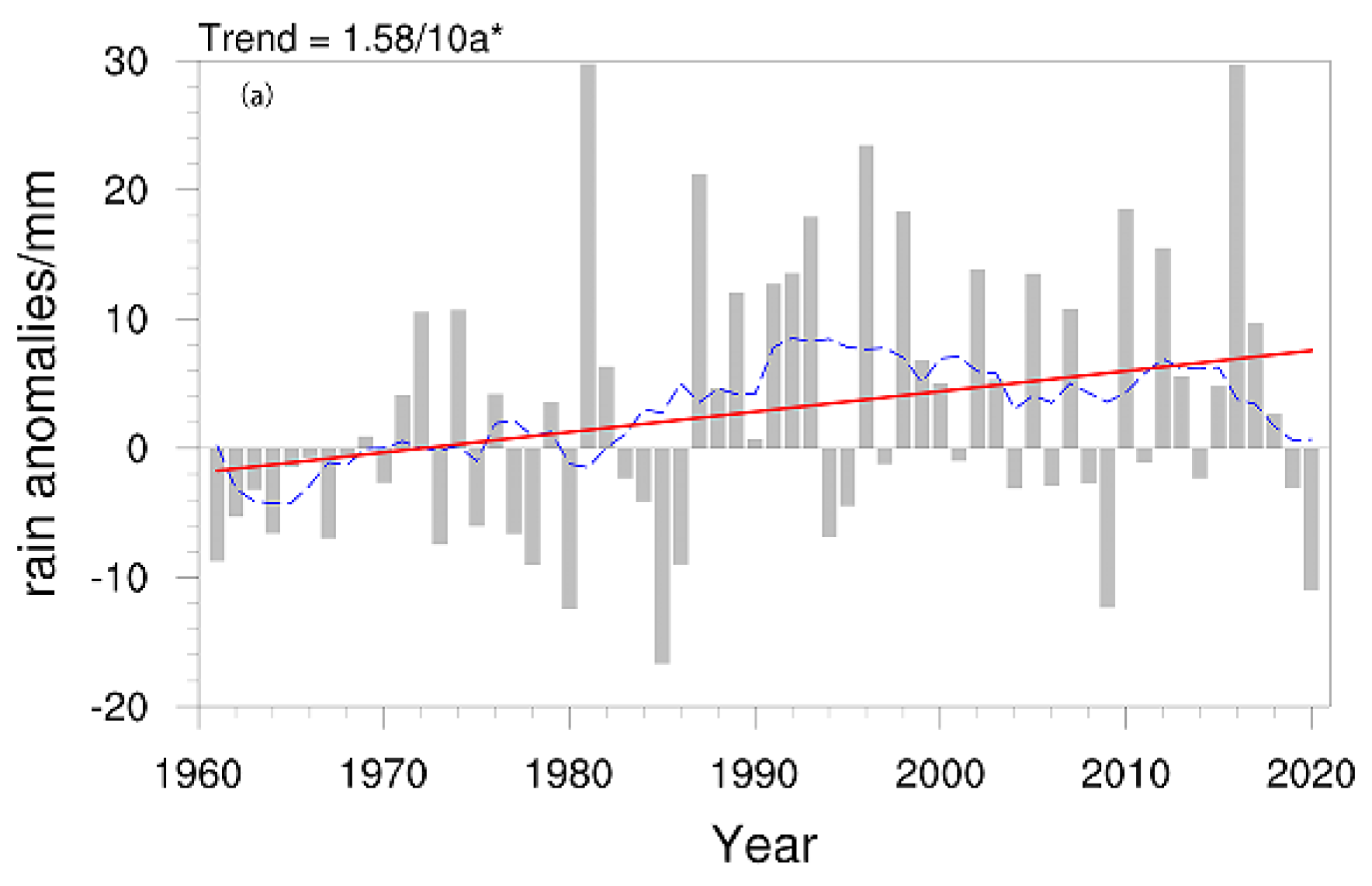
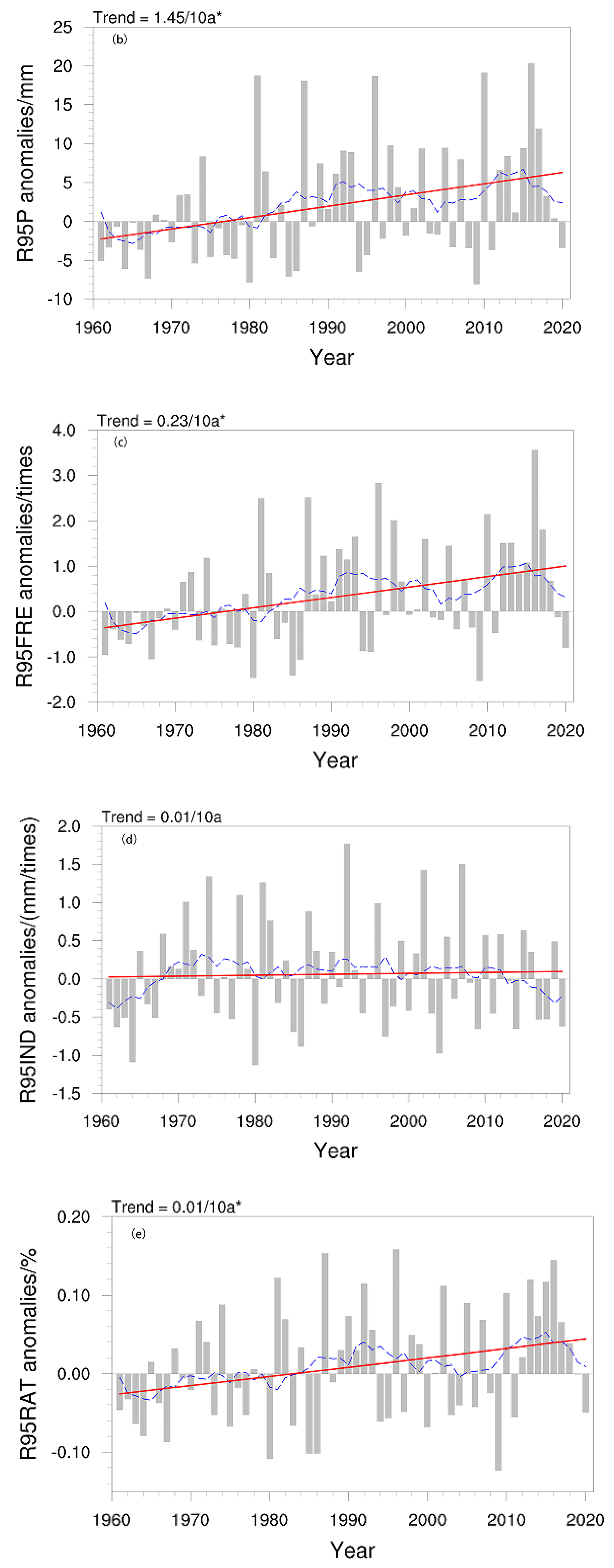
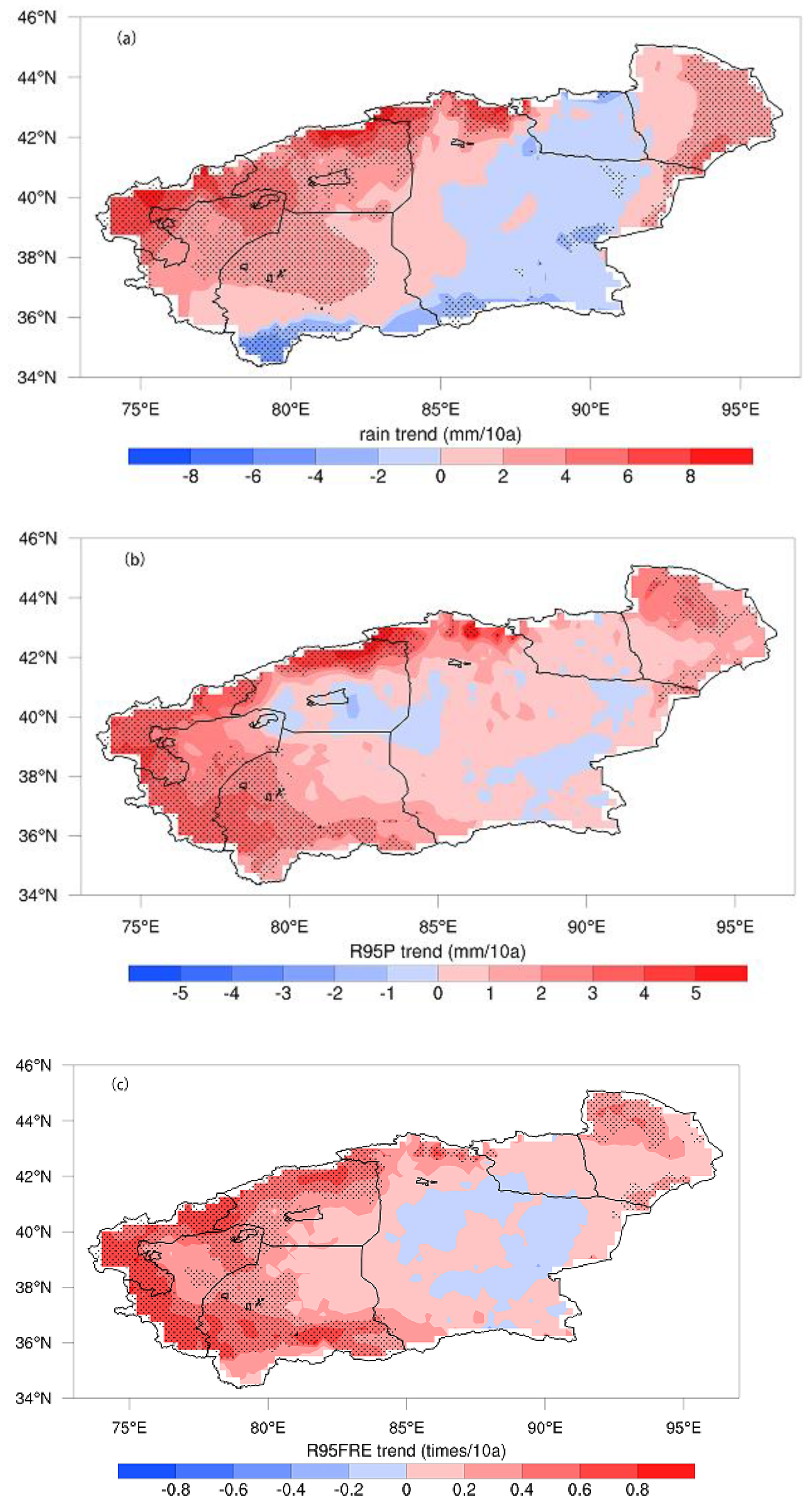
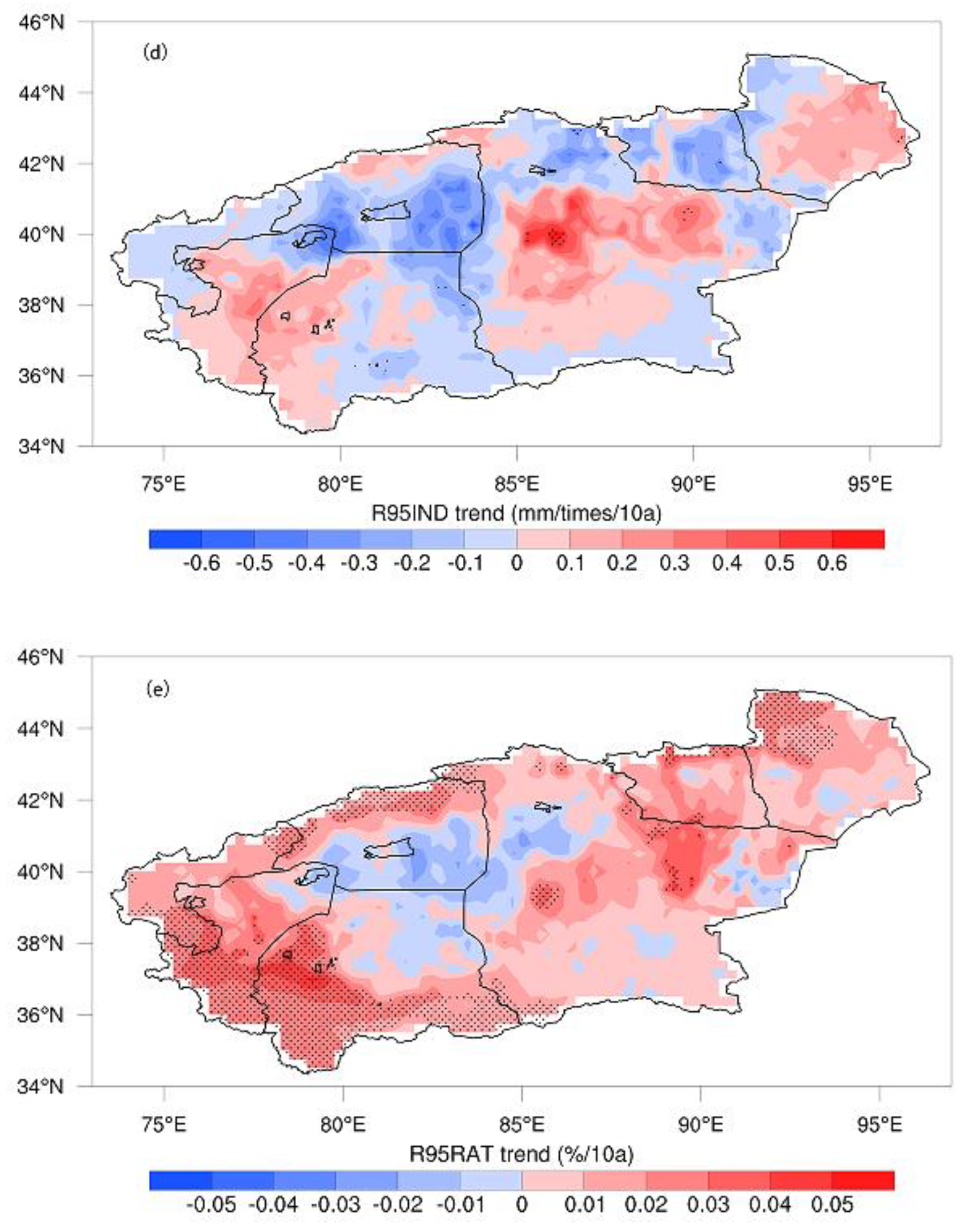
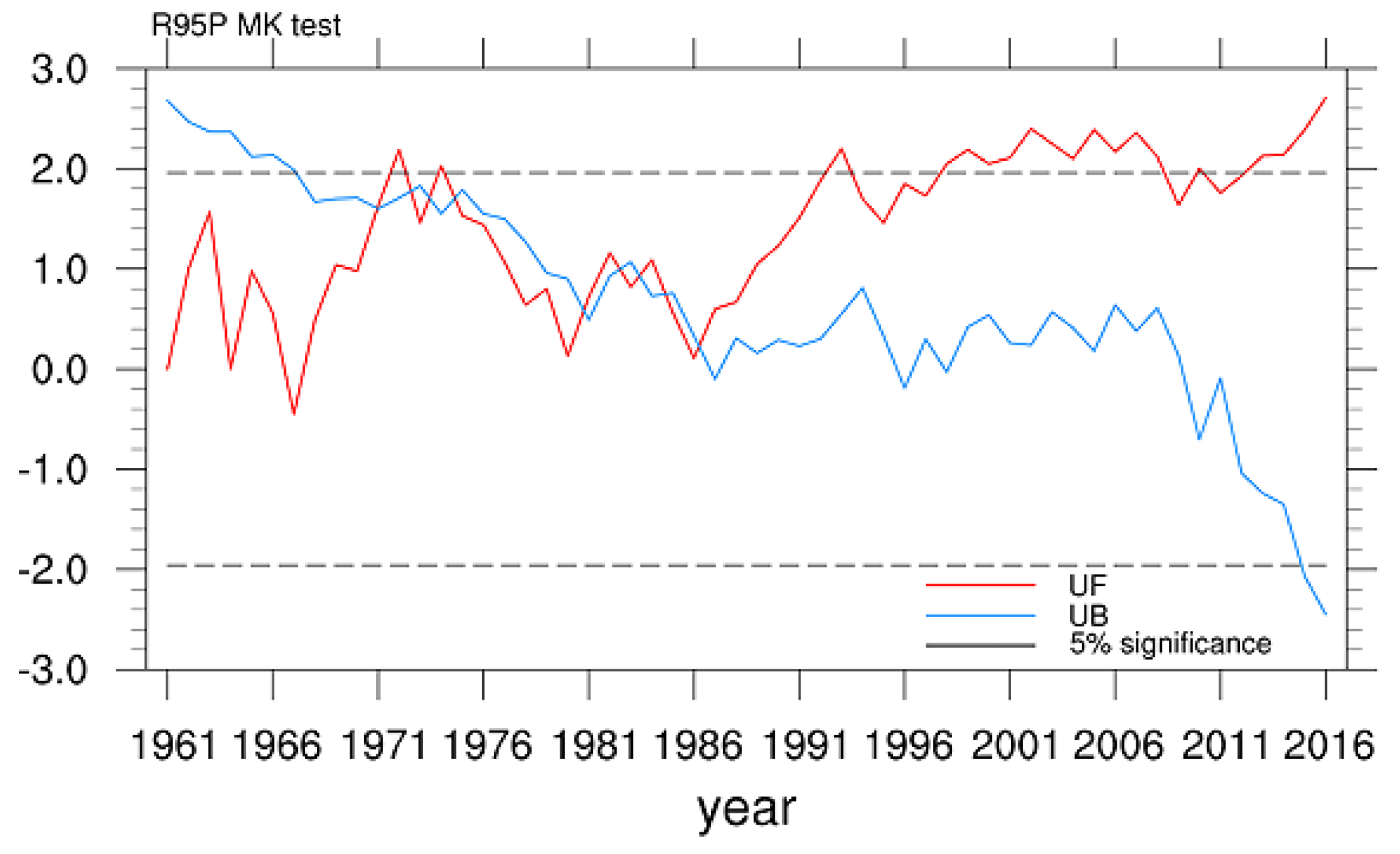

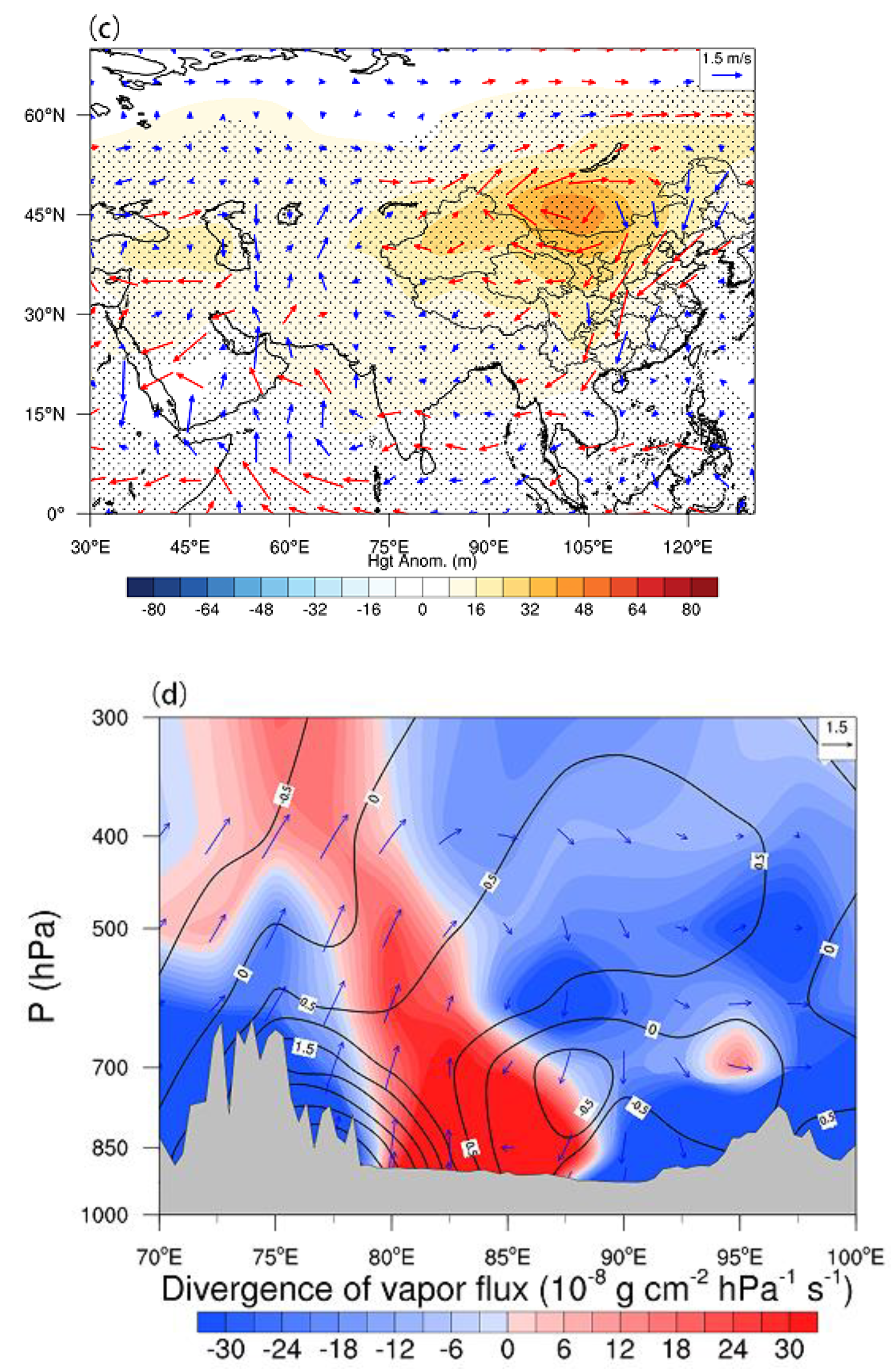
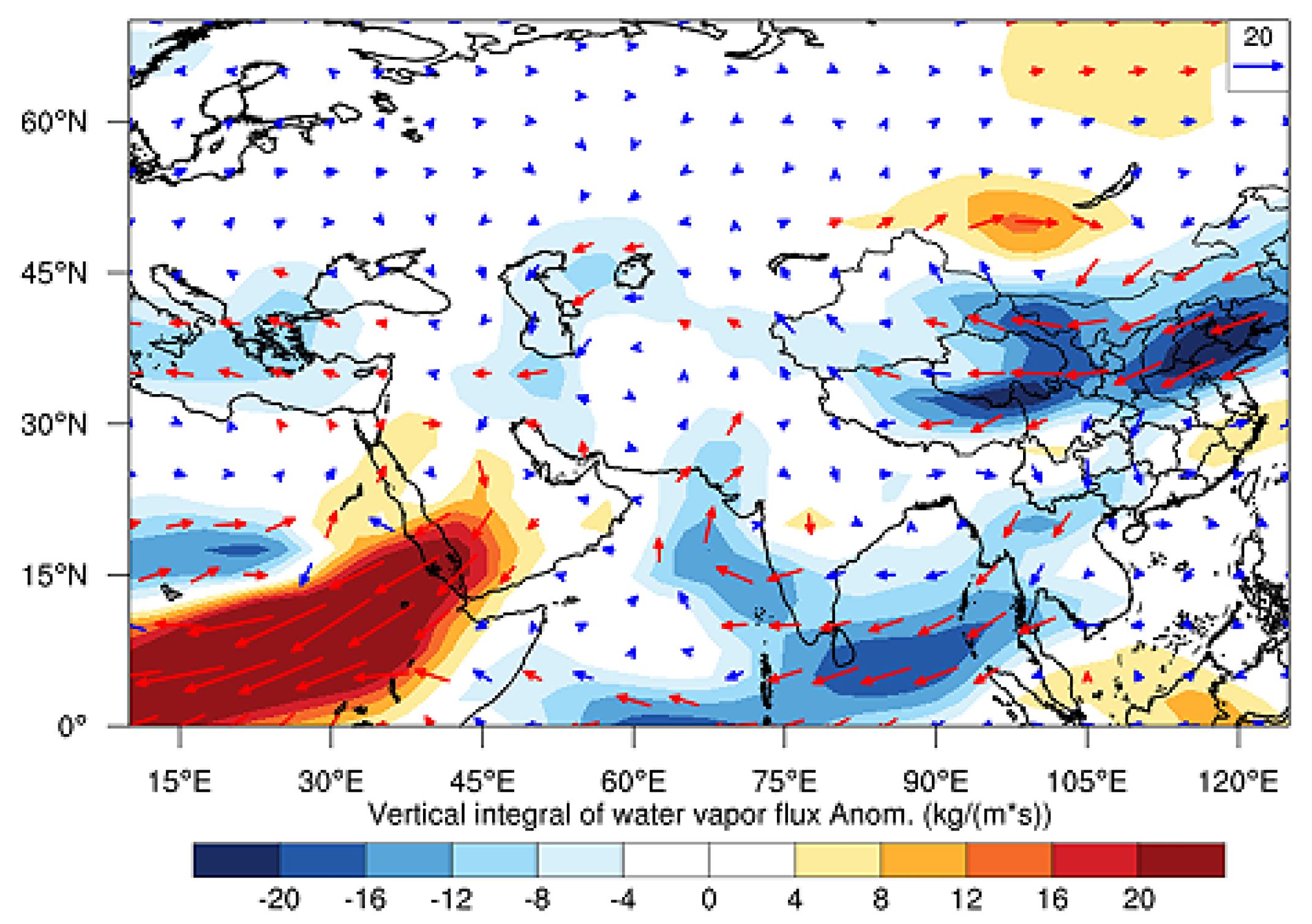

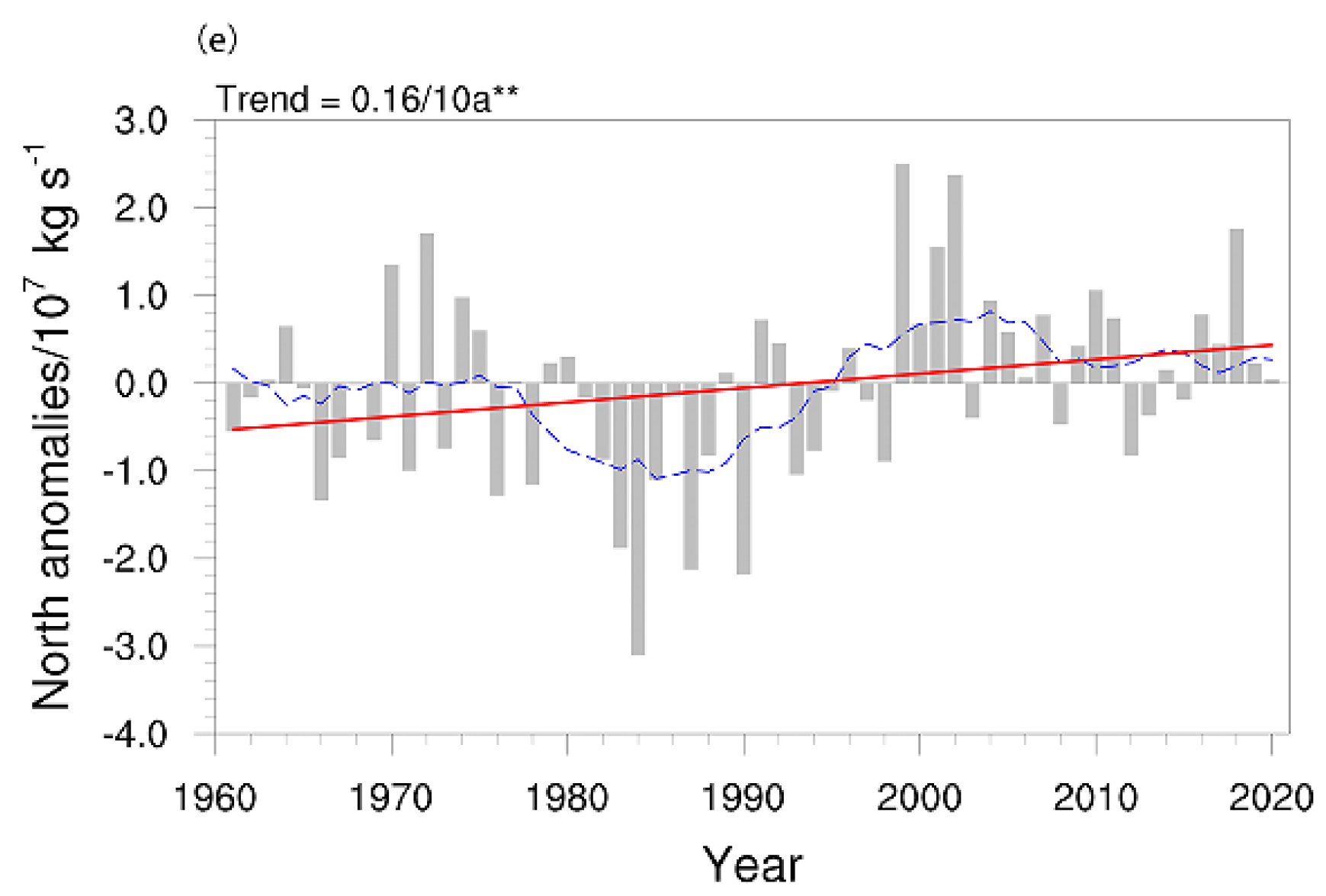
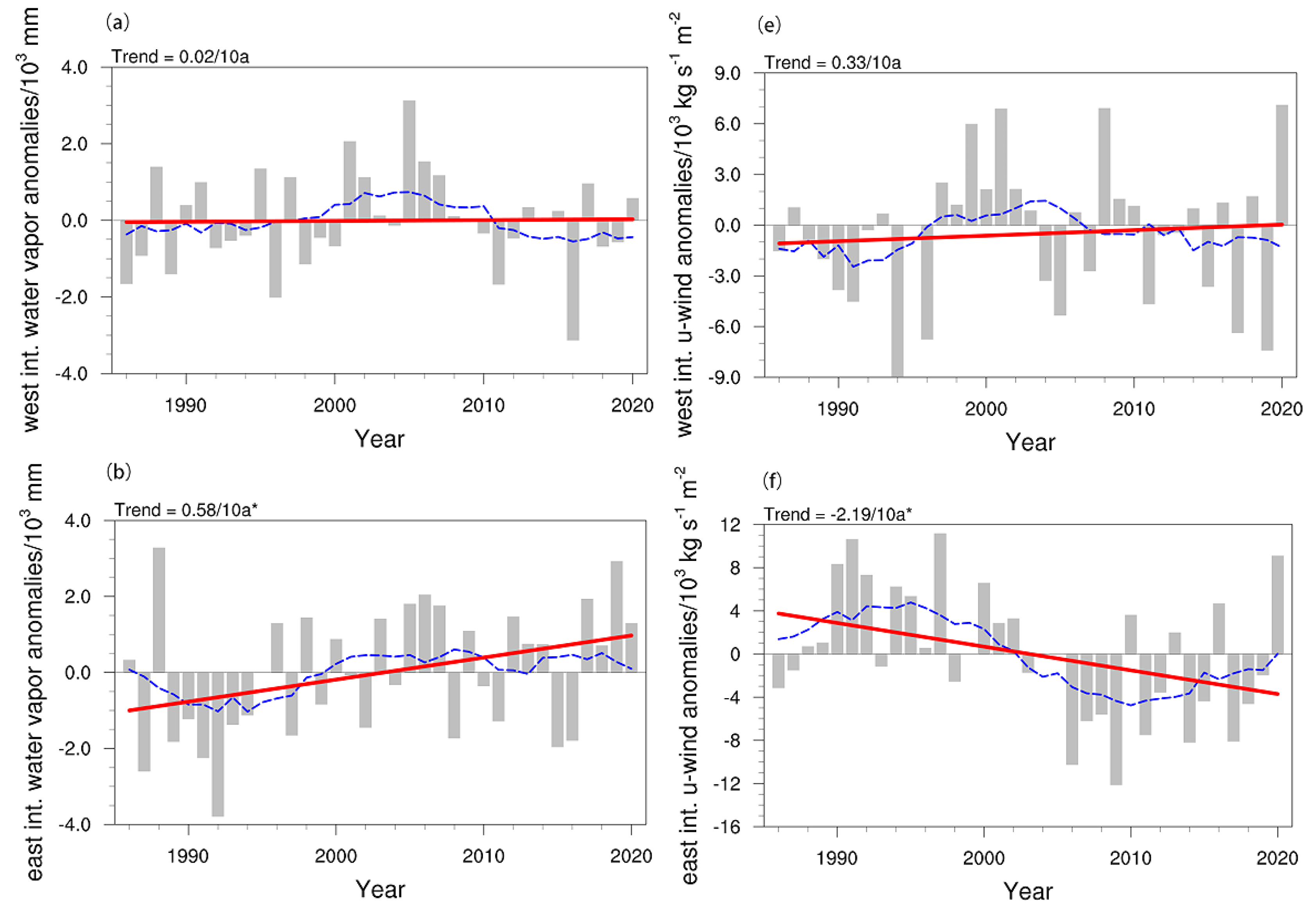
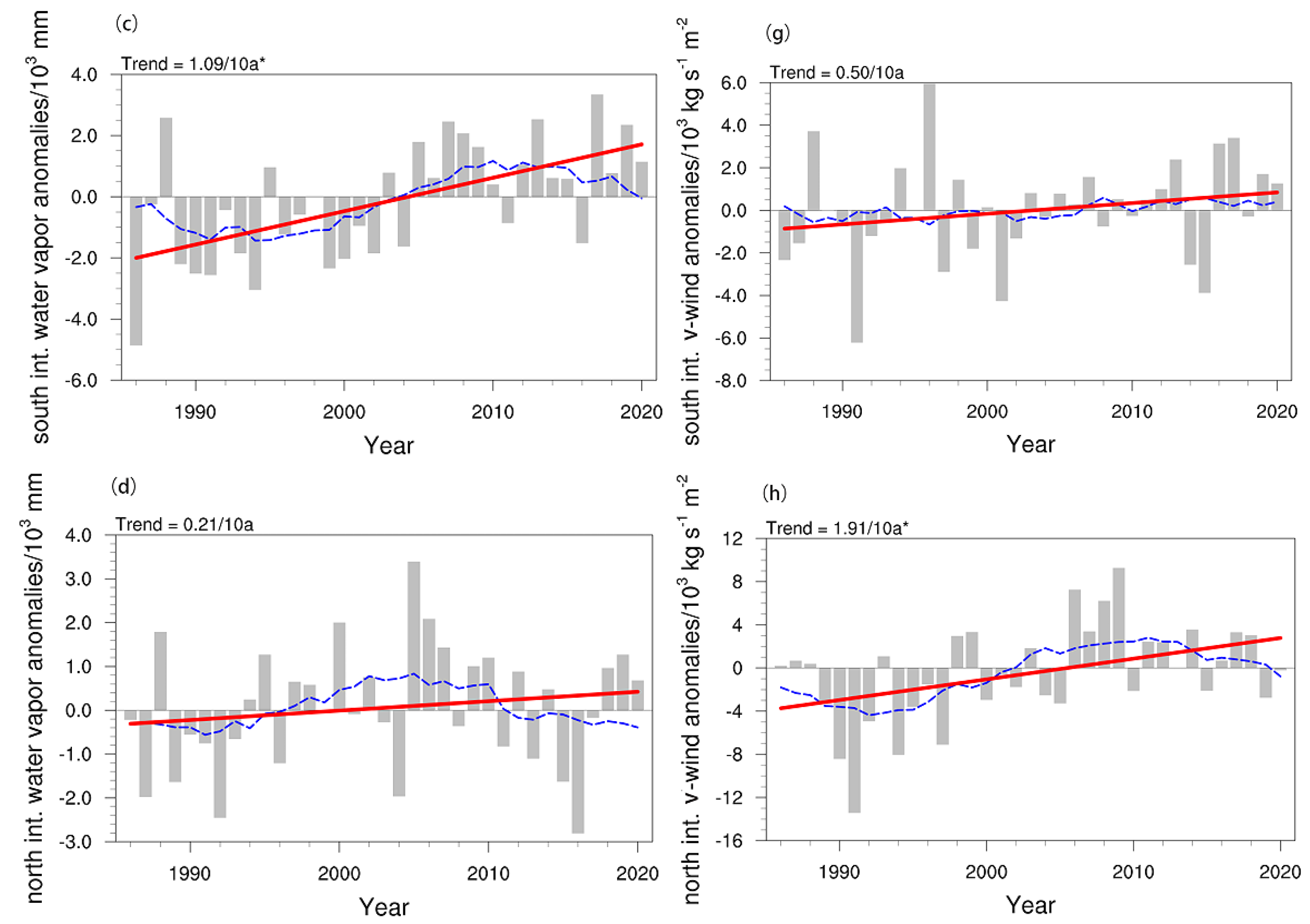



Disclaimer/Publisher’s Note: The statements, opinions and data contained in all publications are solely those of the individual author(s) and contributor(s) and not of MDPI and/or the editor(s). MDPI and/or the editor(s) disclaim responsibility for any injury to people or property resulting from any ideas, methods, instructions or products referred to in the content. |
© 2023 by the authors. Licensee MDPI, Basel, Switzerland. This article is an open access article distributed under the terms and conditions of the Creative Commons Attribution (CC BY) license (https://creativecommons.org/licenses/by/4.0/).
Share and Cite
Jin, C.; He, Q.; Huang, Q. Extreme Summer Precipitation Characteristics and Associated Water Vapor Transport in Southern Xinjiang. Water 2023, 15, 2361. https://doi.org/10.3390/w15132361
Jin C, He Q, Huang Q. Extreme Summer Precipitation Characteristics and Associated Water Vapor Transport in Southern Xinjiang. Water. 2023; 15(13):2361. https://doi.org/10.3390/w15132361
Chicago/Turabian StyleJin, Chen, Qing He, and Qian Huang. 2023. "Extreme Summer Precipitation Characteristics and Associated Water Vapor Transport in Southern Xinjiang" Water 15, no. 13: 2361. https://doi.org/10.3390/w15132361
APA StyleJin, C., He, Q., & Huang, Q. (2023). Extreme Summer Precipitation Characteristics and Associated Water Vapor Transport in Southern Xinjiang. Water, 15(13), 2361. https://doi.org/10.3390/w15132361



